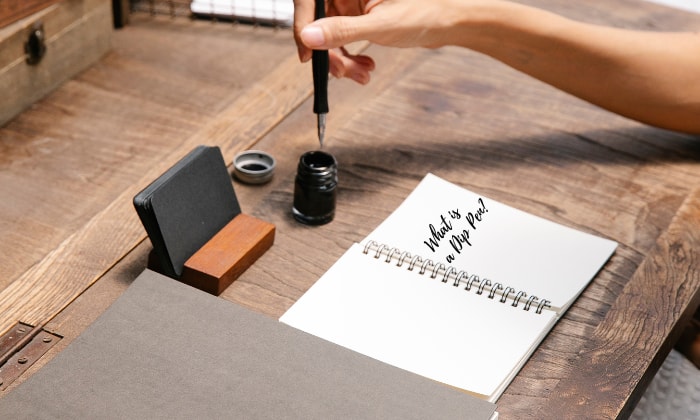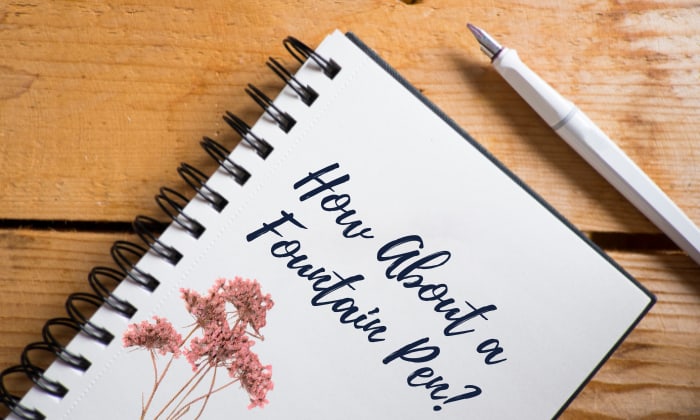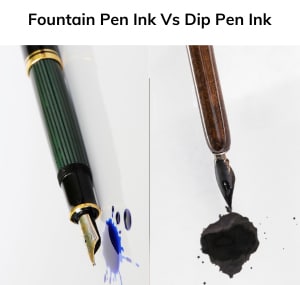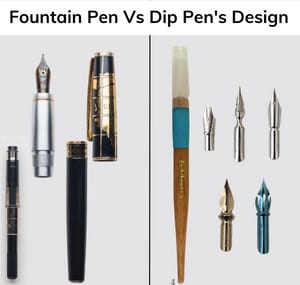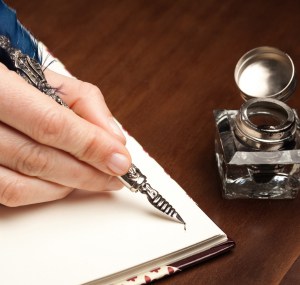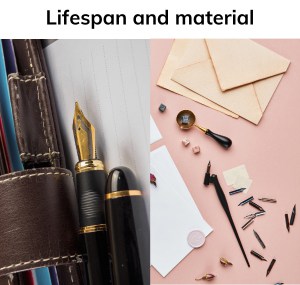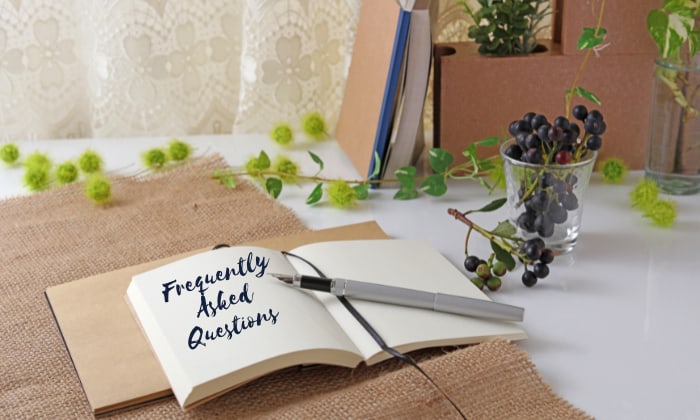If we talk about calligraphy writing, most would instantly think of two classic writing tools – dip pens and fountain pens.
In this article, we will compare and contrast dip pens vs fountain pens. So, whether you’re into calligraphy or just looking for a writing instrument to level up your handwriting, this one will help you through. Let’s start with a short comparison table showing their basic features.
| Features | Dip Pens | Fountain Pens |
| Ink Formulation | Particle- and binder-based | Water-based |
| Ink Consistency | Thick | Thin |
| Ink pathway | Pick up from the nib | From ink reservoir to nib by capillary action |
| Packaging Design | Simple | Complex |
Table of Contents
What is a Dip Pen?
An old writing tool that has been used since the time of the Pharaohs, a dip pen is composed of two simple parts: the nib—available in pointed and italic style—and the handle, whose shape can either be straight or oblique.
Most dip pens’ nibs nowadays are removable, replaceable, and in some cases, interchangeable across types and brands.
One key characteristic of this pen is its lack of ink tube—meaning you’ll need to dip it into an ink bottle or use an ink dropper to make it work. This way, it’ll collect ink through the nib’s channels and grooves. Typically, you can only write for a few lines before having to dip it again.
If you want to switch ink color or type, you can easily do so by washing the nib with dish soap and water or by using a fresh nib, which is pretty affordable anyway.
How About a Fountain Pen?
Fountain pens are writing instruments that have a metal nib and an ink reservoir within their barrel. They typically come in sleek designs and superb craftsmanship.
So, how do fountain pens work? These pens do not require dipping, as they feature an ink supply in the barrel already. From the base, ink is pulled towards the nib by capillary action driven by the adhesive force between the ink and the nib.
Regarding the ink reservoir filling mechanism, there are five main types: cartridge, eyedropper, converter, crescent, and piston. Among these, cartridges are the most convenient and mess-free option.
Fountain pens have many parts, thus cleaning might not be that simple. To clean them efficiently you may have to disassemble them and clean the parts by section.
Related Comparison:
- Which is better: Ballpoint pens or fountain pens?
- Calligraphy pens vs fountain pens: A comparison
- Fountain pen vs rollerball: Which one to choose?
Fountain Pen Vs Dip Pen: Differences
1. Ink
Dip pen ink is particle- and binder-based, meaning it contains finely ground pigments. As such, it has a much thicker consistency than fountain pens’ water-based ink, aside from its waterproof qualities. In contrast, most fountain pens are not waterproof.
2. Design
Each pen is designed differently. As mentioned, fountain pens have ink within their framework while dip pens don’t. The fountain pen parts work like a system while the dip pens parts work individually.
3. Stroke control
Fountain pen nibs are far more controllable than dip pens. This is because dip pen nibs are more responsive and can easily get out of hand, especially if you are a beginner.
4. Tips sizes
Dip pens tend to have smaller tip sizes than fountain pens, and as such, they also produce thinner lines at the expense of being more fragile.
In addition, the thinner tip also means that dip pens’ writing angle is limited to a 90-degree angle, whereas fountain pens don’t have any limitation regarding this aspect.
5. Application
The dip pen is calligraphy friendly and can be used for drawing as well, depending on what nib type you use:
- The pointed tip’s excellent flexibility can expand and contract according to the pressure exerted, making it ideal for calligraphy or drawings.
- The italic nib is stiffer with its rectangular shape, which allows it to produce both broad and fine strokes. You can use these dip pens for writing italics and gothic.
Meanwhile, there are three types of nibs for fountain pens: pointed, stub, and board.
- The pointed tip can produce lines of varying thickness with precise flexibility—an excellent feature for writing and technical drawing.
- Compared to the pointed tip, the stub type is not as flexible. It’s fine balanced between rigidness and flexibility makes it a fine asset for everyday writing.
- Pens with a board nib can also produce line thickness variations, along with italic writing.
6. Lifespan and material
The lifespan of a pen highly depends on the type of materials used to produce them.
Dip pen nibs are mostly made of soft spring steel, whereas the handle can be made of wood, bone, plastic, or metal. You can also find a fancy type like the glass dip pen.
Luxury fountain pens’ bodies can be made with metals like silver, brass, and gold, while the less pricey ones are made with plastic like polymers, acrylics, and cellulose acetate.
So, the takeaway here is that fountain pens are made with more durable materials that can last for decades. Dip pens, on the other hand, have fairly durable handles, but their nibs are disposable.
Pros and Cons
1. Fountain pens
- Have an ink reservoir
- Well crafted
- Easier to control
- Can last for a longer time
- Some fountain pens can also be used for drawing
- Expensive
- Might be hard to clean
2. Dip pens
- Cheaper
- Easy to clean
- Can use various ink in one nib
- Suitable for both drawing and writing
- Requires frequent dipping
- Less control
- Nibs require frequent replacement
Which is Better?
Determining which pen is better will entail different factors. These factors can vary depending on the person’s bias, budget, and more. In short, what works for me may not work for you.
If you want to write continuously without much interruption, a fountain pen might be better for you, as they have a reservoir of ink that can last longer. In contrast, dip pens require frequent ink dipping.
On the other hand, if you use different colors and don’t like the hassle of refilling ink and cleaning the nib, a dip pen is better, as you can just change your nib. Dip pens can also handle various kinds of ink, whereas fountain pens are only compatible with water-based formulas—any other types will clog them up.
Frequently Asked Questions
Can fountain pens be used as dip pens?
Yes, you can use a fountain pen as a dip pen. Fountain pen tips can still pick up ink from dipping and can write with no problem. However, note that fountain pens’ nibs can rust if utilized this way, so I’d suggest using a dip pen regardless.
Can I write calligraphy with fountain pens?
Yes, you can absolutely do calligraphy with fountain pens. However, you should opt for pens with a broad nib, as you can produce various strokes and line thicknesses with varying angles.
What are the parts of a fountain pen nib?
A fountain pen nib consists of the following parts:
- Tipping material
- Slit
- Tines
- Shoulder
- Breather hole
- Imprint
- Body
- Base
A slotted base connects the nib and the barrel. The body provides space for the imprints and partly holds the feed, while the slit, breather hole, and tines facilitate ink and airflow. Lastly, the tipping material, whose dimensions determine the final writing size.
Are there fountain pens for drawing?
Yes, there are several fountain pens that are good for drawing, but first, you have to consider some factors that can greatly affect your drawing. These are the nib size, type, and flexibility.
Here are some of the best fountain pens you can use for drawing:
- Pilot Prera
- Noodler’s Konrad Flex
- Zebra Zensations
- LAMY Safari
- Pilot Parallel
- Hero 330 Fude
- PenBBS 469 Double Nib
- Pilot Falcon
- Pelikan Classic M200
Conclusion
When it comes to calligraphy writing, whether to use dip pens vs fountain pens depends on the nib of a pen. Both can be used for calligraphy, given that you select the correct nib for the job.
Moreover, your personal preference and your budget are only a few additional factors that have to be considered before making a decision.
As we part ways, we hope that this article has anyhow cleared some of your questions in choosing your calligraphy writing companion.

Art has always been a part of my life; it influences my upbringing and later my career choice. For me, it is always a part of my parenting technique. So for whichever purpose that you come to art, you can start here with us.

